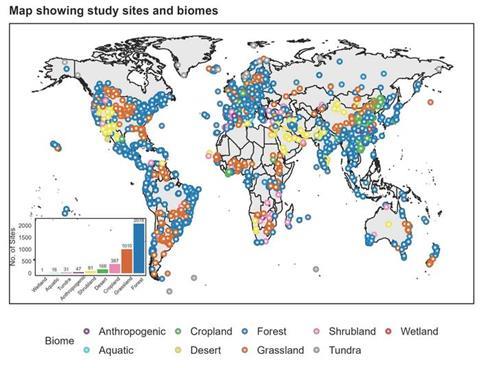Many soil microbes play a vital role in ecosystems, as they help plants access nutrients and water and assist in stress tolerance such as during drought and to defend against pathogens.

One such group of soil microbes are arbuscular mycorrhizal, aka AM, fungi. These important fungi are essential to plant health and are associated with the roots of approximately 70% of plant species on land. Through their symbiotic relationship with plant roots, the fungi contribute significantly to the carbon cycle and other processes that sustain ecosystem functioning.
READ MORE: Fungal-rich soil may improve green roofs
READ MORE: Climate change is moving tree populations away from the soil fungi that sustain them
A fungus’s spores are responsible for fungal reproduction and dispersal. And spore traits, including volume, cell wall thickness, ornamentation such as projections or depressions in the cell wall, shape, and color, can affect how well fungi survive in different environments.
Multiple traits
A new Dartmouth-led study reports on how global climate conditions affect AM fungal spore traits and the species biogeographic patterns. The study is the first to examine multiple traits of this kind on a global scale. The results are published in the Proceedings of the National Academy of Sciences.
“As climate change continues, we expect shifts in these microbial traits that influence how these fungi survive, spread, and interact with plants, which could have cascading effects across ecosystems, and affect restoration efforts and food production,” says lead author Smriti Pehim Limbu, a postdoctoral fellow in the Ecology, Evolution, Environment & Society Program and member of the Chaudhary Ecology Lab at Dartmouth.
Global databases
For the study, the researchers synthesized data from different global databases of AM fungal species with climate data, to examine how climate affects the spore traits. These included TraitAM—a public database of the spore traits of more than 340 AM fungi, created by senior author Bala Chaudhary, an associate professor of environmental studies at Dartmouth.
“Our findings showed that spores that were bigger and darker in color were more common in warm, wet climates, but there was a trade-off between persistence and dispersal,” says Pehim Limbu. “While being bigger helped the spores to persist in warm, wet conditions, these conditions were associated with a more limited geographical distribution.”
Spore patterns
Spores with more cell surface ornamentation were also more common in warm, wet climates but had smaller geographic distributions. Darker spores, which have more pigment, were more common in warm, wet climates. According to the co-authors, those attributes may help protect the fungi from ultraviolet radiation and fire.
Yet, cell wall thickness for spores decreased in warm, wet climates and was more robust in cooler, drier climates. Intermediate cell wall thickness was found to be associated with broader geographic distribution.
By understanding which AM fungal spore traits thrive in specific climates such as dry versus humid climatic conditions, the co-authors report that the findings could guide commercial applications of bioinoculants, microbial amendments used for soil restoration, through selection of AM fungi suited to the local environment.
Pre-dating Darwin
“Ecologists since before Darwin have been studying the geographic distribution of species’ traits,” says Chaudhary.
“For example, we know that mammals with white fur are more likely to occur in cold climates. This study takes an important step in uncovering similar patterns for the traits of microbes, giving insight into the environmental adaptations of the majority of biodiversity on Earth.”







No comments yet